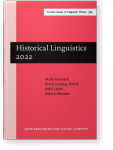The semantics of word borrowing in late medieval English
A preliminary investigation
The paper presents a pilot study investigating the extent of sense sharing between loanwords in Middle
English and their etyma in French and Latin, undertaken as part of a new three-year project. Fifty loanwords have been
examined, with all senses in the borrowing and donor language(s) recorded using the major historical dictionaries. These have
been standardised and mapped onto a framework using the categories of the Historical Thesaurus of English
(Kay et al. 2022) to allow comparison. Our main results show that polysemy is
nearly always mirrored but complete semantic overlap is rare; that senses unique to Middle English are common but short-lived;
and that figurative senses are almost never borrowed into Middle English without the original literal senses.
Article outline
- Introduction
- 1.Methodology
- 1.1Collating the main loanword dataset
- 1.2Selecting the data for the pilot study
- 1.3Comparing senses across borrowing and donor languages
- 2.Results
- 2.1Polysemy
- 2.1.1Semantic overlap
- 2.1.2Loanword senses unique to Middle English
- 2.2Figurative senses: Metaphor and metonymy
- 2.2.1‘Native’ versus ‘borrowed’ figurative senses in Middle English
- 2.2.2Literal versus figurative senses
- 2.3Narrowing and broadening
- Conclusion
-
Notes
-
Abbreviations
-
References
This content is being prepared for publication; it may be subject to changes.
